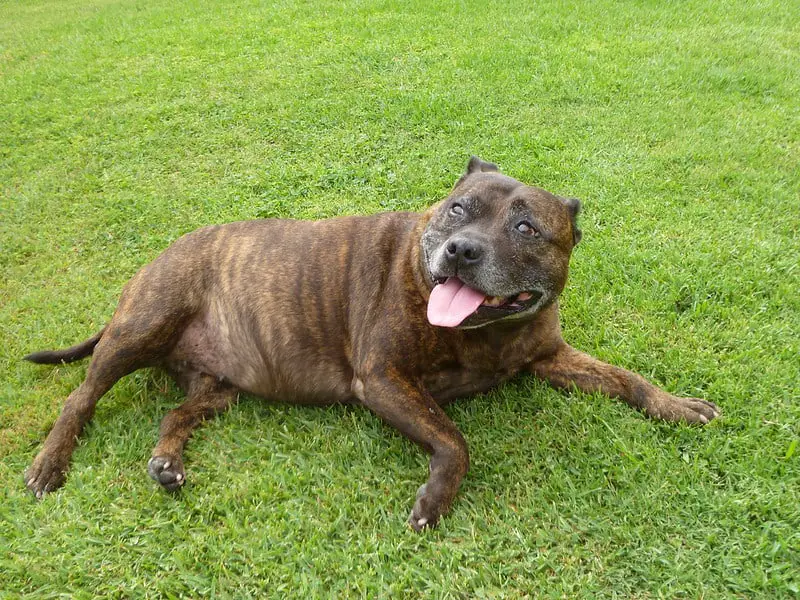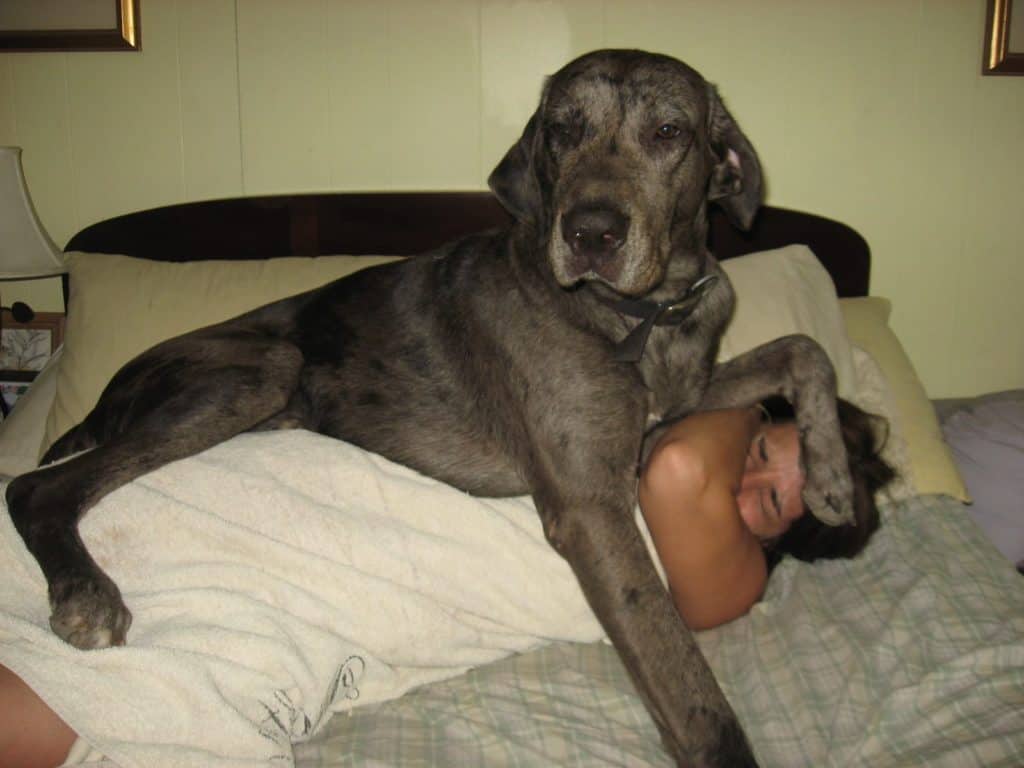
Perhaps not nearly as exotic as some other animals like flamingos or rhinos, there’s no denying that there are some aspects of the dog’s anatomy that baffle and elude us.
Some dogs have unique tails, while other dog breeds have unusual, drooping ears. And, of course, a dog’s paws are one of a kind, too.
As well as these features, some breeds of dog have distinct claws, called dewclaws. But do American Bulldogs have dewclaws? That is what this article will focus on:
What are dew claws?
Ever seen those “thumbs” that some dogs have? Perhaps you’ve noticed a dog using them to stabilize a bone they were eating, or to defend a ball or other toy.
These thumbs that dogs have are sometimes called digits, or vestigial structures.
But did you know that there is nearly always a claw attached to these canine “thumbs”? This claw may not be as obvious as a dog’s other claws – being buried in their fur.
These claws may even have been removed from a dog shortly after they were born. But whether you’ve noticed them previously or not, these higher-up thumb claws are called dewclaws.
Why do animals have dew claws?
So, many breeds of dogs are born with dew claws on their “thumbs”. But what about other animals? Do other animals have dewclaws, and what do they use them for?
Yes, plenty of other animals besides dogs also have dewclaws. Pigs and horses, for example, used to have dew claws before these partially adapted away. Also, many reptiles and even some species of birds that are still alive today have dewclaws that they find very useful in their day-to-day lives.
But why do these animals have dew claws? What are they used for? Well, the main use of dew claws seems to have been to climb up trees, in ancient times. But some animals, like cats, have been spotted using their dew claws to climb up rocky cliffs or to sprint across rough terrain.
And, of course, birds always use their dew claws to forage on the ground and to grip tree branches. Also, lions use their dew claws to help them to hunt.
But for today’s dogs, dew claws are fairly redundant, especially when they live as pets. Instead, dogs are mainly adapted for running. When they run, a dog’s toes are the only thing making contact with the ground.
This method of running serves dogs so well, they are regarded as the second-fastest land animal, pipping cheetahs to the post any day now! But their dew claw does not aid a dog with this.
Which dog breeds have dew claws?
So, how many dog breeds still have dew claws today? Well, these include the Briard, the Estrela Mountain Dog, the Anatolian Shepherd, the Norwegian Lundehund, Great Dane, St Bernard, Catalan Sheepdog, Chihuahua, American Pitbull, and, of course, the English Bulldog, from which the American Bulldog was bred.
Many of the dogs listed above are rescue dogs, and it’s clear their dew claws aid them with certain aspects of this, like gripping stones when they need to traverse treacherous mountain paths.
But the dew claws of some of these dogs, like the Great Dane or Doberman, are instead loose and delicate, hanging by only their skin, and generally need to be removed for health reasons.
What is the history of the American Bulldog?
Did you know that the American Bulldog was first bred from the Old English Bulldog?
The American Bulldog was also formerly a farmyard dog, with whom jumping up to six feet in the air and sprinting for miles after straying cattle and sheep was the daily norm of their life.
This strenuous and unique lifestyle has caused the American Bulldog breed to develop several specialized features, that they still retain to this day. For example, they have a unique jaw, that lets them get an incredible grip on bones and treats.
And, of course, they have their dew claws that once aided them so well in their farm life, to allow them to climb, chase and stabilize their bone or chew toy.
Do all American Bulldogs have dew claws?
Have you ever gone to view a litter of American Bulldog puppies, only to find that none of the puppies has their dew claws? What’s going on?
Have their claws just not grown yet, or do some American Bulldogs never grow claws? Well, it’s true that some American Bulldogs just don’t have the gene for dew claws, and will never grow them.
But it’s more likely that the breeder has already removed the dew claws from the puppies. If present, many breeders will remove an American Bulldog’s claws at around 1-3 days old! At this early stage in their life, an American Bulldog puppy has no developed nerve endings here.
It’s comparable to tail docking or ear cropping, though it is considered more humane than these procedures.
Why do people remove American Bulldog’s dew claws?
But why would anyone carry out this seemingly unnecessary procedure? Surely with all the advantages that an American Bulldog’s dew claws have, it would be better to leave them on, right?
For sure, an American Bulldog’s dew claws undoubtedly have a vast amount of advantages, or else why would they have them? But an American Bulldog’s dew claws do also bring a few major health concerns.
Whether they have dew claws on their forelegs or on their hind legs too, an American Bulldog with their dew claws intact continually runs the risk of having their dew claws quite badly injured.
Their dew claws may get yanked out in long grass while playing fetch, or caught in rugs and mats around the house.
How can I prevent injury to my American Bulldog’s dew claws?
Did you know that the first thing most American Bulldog owners know about their pooch’s dew claws is when they get injured? Before this, many owners report that they had no idea that dew claws even existed!
But when you know that your American Bulldog has dew claws, there are a few things you can do to mitigate the risks associated with a dog having their dew claws intact.
One great thing you can do is, always make sure that your American Bulldog’s dew claws are kept trim and short, just like their other claws. This is because their dew claws, since they do not often touch the ground, do not get naturally worn down by walking outdoors.
Another thing you can do if your American Bulldog has dew claws is; inspect the areas of your home that your pooch frequents the most, like the area where their bed is kept, or your living area.
Take a look at the soft furnishings in this area. Are they in any way hazardous to your American Bulldog’s dew claws – do you have, for example, loosely woven blankets or cushions?
Since furnishings like these can easily snag your American Bulldog’s dew claws and cause an injury, consider storing them in a place out of reach from your American Bulldog.
Conclusion
So to conclude, yes, most American Bulldogs are born with dew claws, though since their dew claws are not that useful in their day-to-day life and are regarded as something of a hindrance, many American Bulldogs have them removed at a very young age, while others are born without them.
That being said, many American Bulldogs who are born with their dew claws live their entire lives without any adverse incidence, as long as their owner is aware of their dew claws and how to maintain them properly.
For more about American Bulldogs see my other articles below
- Do American Bulldogs Like Water?
- Do American Bulldogs Bark a Lot?
- Do American Bulldogs Need a Coat in the Winter?
- Do American Bulldogs Need a Lot of Exercise?
- Do American Bulldogs Sleep a Lot?
- Do American Bulldogs Need C-Sections?
- Do American Bulldogs Drool a Lot?
By Michelle McDaid


